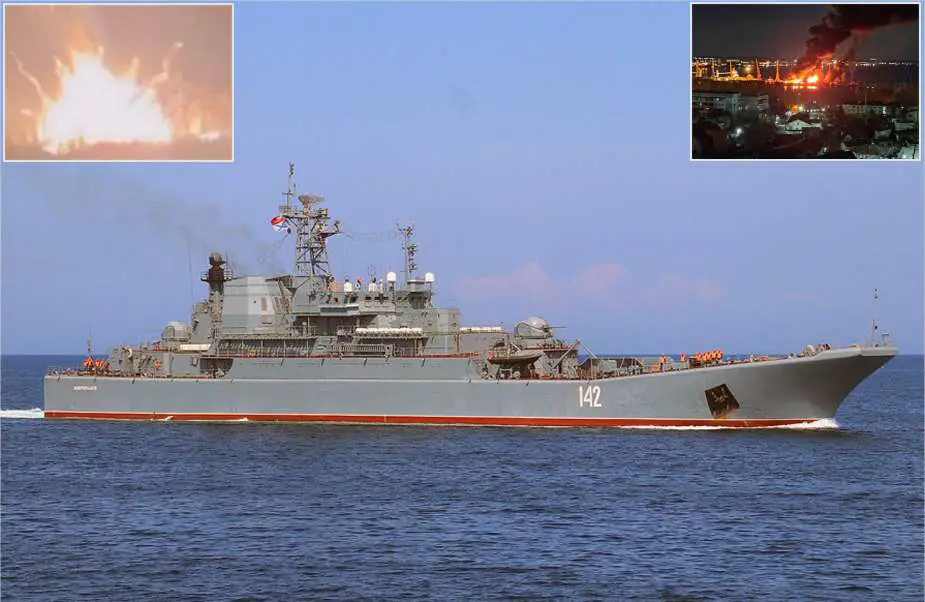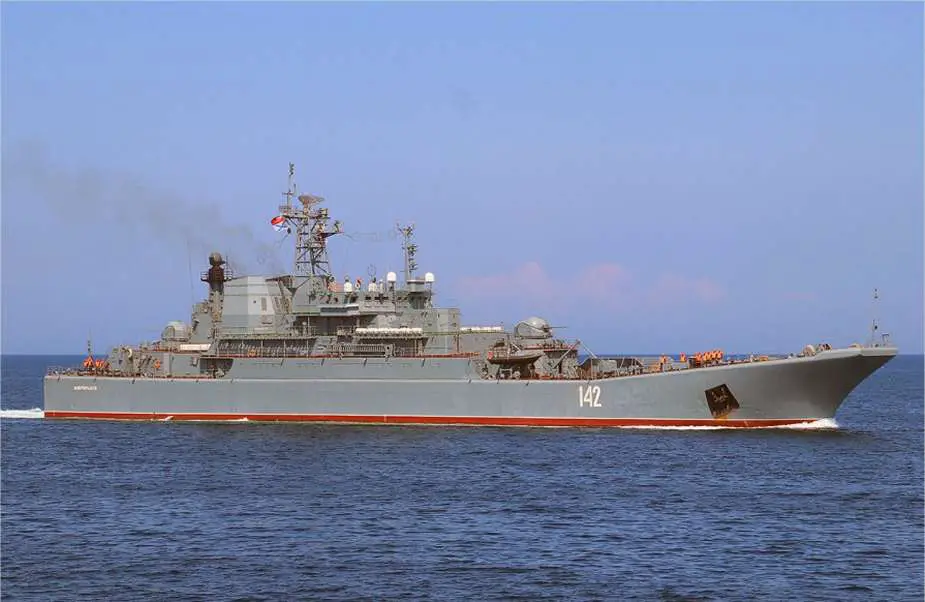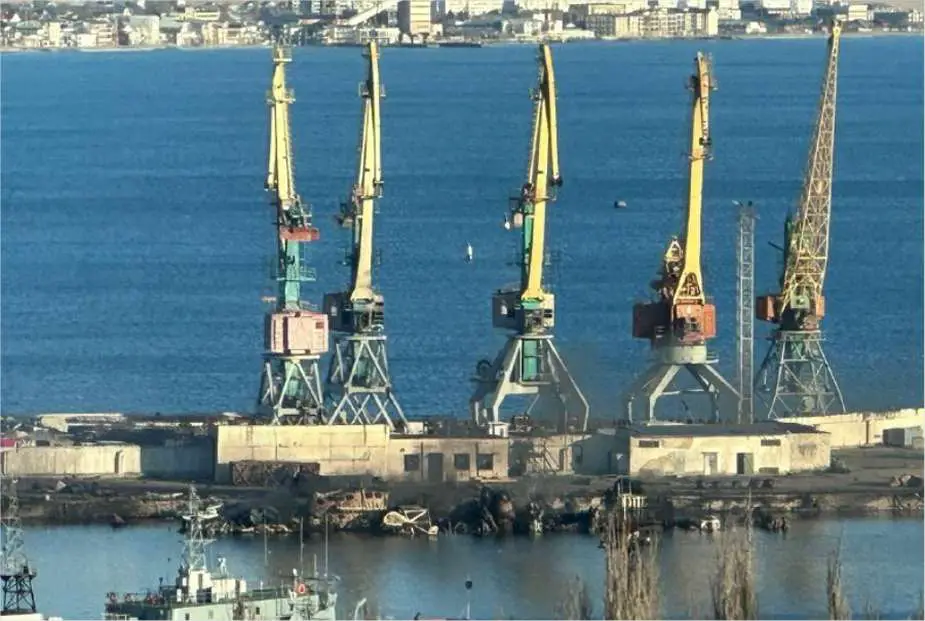Breaking news
Ukraine claims the destruction of Russian Navy's Novocherkassk Ropucha-class landing ship.
On December 26, 2023, the Russian Ministry of Defense confirmed an incident in the Crimean port of Feodosia, where the Ukrainian Armed Forces targeted the Novocherkassk (BDK-46), a Ropucha-class landing ship of the Russian Navy's Black Sea fleet. This event, confirmed by both Russian and Ukrainian sources, has generated various interpretations, some of which suggest that the ship may have been irreparably damaged.
Follow Navy Recognition on Google News at this link
 Ukraine's attack leaves the Russian Navy's Novocherkassk Ropucha-class landing ship in flames, potentially due to the presence of an explosive cargo inside the ship. (Picture source: Yandex, Twitter/OSINTdefender, and Twitter/Defense of Ukraine)
Ukraine's attack leaves the Russian Navy's Novocherkassk Ropucha-class landing ship in flames, potentially due to the presence of an explosive cargo inside the ship. (Picture source: Yandex, Twitter/OSINTdefender, and Twitter/Defense of Ukraine)
According to the Russian Ministry of Defense, in a statement reported by TASS, the Novocherkassk sustained damage following an airstrike. This attack was reportedly carried out by at least two Ukrainian Su-24 aircraft, which employed guided missiles. Russian defense systems responded by downing these aircraft near the village of Zhovten, located northeast of Mykolaiv.
As a result of the strike, there was one reported casualty and damage to six nearby buildings, according to Sergei Aksyonov, the Russian-appointed head of Crimea. He also mentioned that some individuals affected by the incident were relocated to temporary accommodations. Despite the inflicted damage, the operational capabilities of the Feodosia port were reportedly not compromised. The fire resulting from the attack was contained, and the area was secured.
In contrast to the Russian report, Mykola Oleshchuk, the Commander of the Ukrainian Air Force, likened the fate of the Novocherkassk to that of the Moskva, a former flagship of the Russian Black Sea Fleet. The Ukrainian Air Force claimed through Facebook that their forces conducted the strike using cruise missiles at around 0230 (0030 GMT), resulting in the destruction of the landing ship.
The choice of weaponry used in the strike has been a subject of discussion on social media. For example, according to H.I. Sutton, Ukraine potentially used Storm Shadow cruise missiles. These missiles were probably launched from Su-24 bombers, the type of aircraft that Russia claimed to have destroyed. Social media reports also describe multiple explosions and fires at the Feodosia port, challenging the Russian account of the event. These explosions reportedly caused extensive damage to the surrounding area, including significant damage to the Feodosia-Tovarna railway station.
According to a later tweet from Trent Telenko on December 27, 2023, the explosion aboard the landing ship Novocherkassk was likely caused by the detonation of the considerable arsenal it carried. Equipped with a naval version of the BM-21 launcher, the Novocherkassk carried a total of 320 rockets used for area suppression. The simultaneous ignition of these rockets is comparable to the simultaneous destruction of eight BM-21 Grad units.
Additionally, the ship's cargo also included a significant amount of 152mm artillery shells. Each one of the 44,000 shells contained about 7.9 kg of TNT and between 8.1 to 8.9 kg of propellant. The cumulative mass of TNT and propellant in these shells contributed to the potential for a large-scale explosion. Although the propellant lacks the shattering effect of high explosives, its sheer quantity added to the overall explosive potential on board.
Reports also indicated the presence of Shahed-136 drones on the Novocherkassk, maybe from the last evolution, which is equipped with a 40 kg thermobaric warhead. The number of these drones was not specified, but their inclusion, particularly with thermobaric warheads known for their intense blast effects, would have significantly increased the explosion's magnitude.
This hypothesis is supported by damage observed at significant distances, such as at an occupied Crimea railway station, approximately 600 meters from the blast site, where damage was consistent with a 2-to-3 PSI blast wave.
Some sources suggest that the Novocherkassk might have been carrying a substantial amount of explosive material, possibly including munitions and Iranian Shahed kamikaze drones. Other sources speculate that the strike's targets might have extended beyond the Novocherkassk to other naval vessels and cargoes, potentially carrying munitions, belonging to both the Russian and, possibly, the Iranian fleets.
In the aftermath, unverified social media statements have circulated regarding the human cost of the strike. One of these reports suggests a significant number of casualties among the Russian naval personnel, with several ambulances observed in Feodosia, indicating a substantial emergency response effort. The number of sailors on board the Novocherkassk at the time of the strike is believed to have exceeded a hundred.
Following Russia's annexation of Crimea in 2014, the peninsula has been a focal point of military operations in the region, especially since the onset of Russia's invasion of Ukraine in February 2022. Russian forces in Crimea have faced numerous attacks. Ukraine's military claims to have destroyed and damaged several Russian navy ships in the Black Sea since the conflict began. As reported on Twitter, the first attack attempt on the Novocherkassk took place on March 24, 2022, in the occupied port of Berdiansk.
After several Ukrainian missile strikes on their Black Sea fleet vessels and headquarters in Sevastopol, Russia recently relocated much of its fleet from Crimea to the Russian Black Sea port of Novorossiysk, as confirmed by satellite images.

The Novocherkassk can transport cargo loads of up to 500 tons with an impressive operational range of up to 4,000 nautical miles (11,000 km). (Picture source: Yandex)
The Novocherkassk is a large landing ship from the NATO reporting name Ropucha-class, known as Project 775 in the Soviet naval classification. These landing vessels were constructed at the Stocznia Polnocna shipyards in Gdansk, Poland, for the Soviet Navy and were revered for their capabilities in beach landings. Like its counterparts, the Novocherkassk has the ability to carry an impressive cargo load of up to 500 tons. These vessels were produced from 1975 to 1991, with the final three ships representing the improved Project 775/III variant, also known as Ropucha II.
One of the distinguishing features of these ships is their flexibility in cargo handling. Equipped with both bow and stern doors, they facilitate efficient loading and unloading of vehicles and equipment. The expansive vehicle deck extends across the entire length of the hull, covering an area of 630 square meters, making them well-suited for beach landing operations.
While primarily designed for roll-on/roll-off operations, these vessels also offer the option of being loaded using dockside cranes. To facilitate this, a long sliding hatch cover is situated above the bow section, providing access to the vehicle deck.
Notably, these ships are renowned for their impressive operational range. They can achieve speeds of up to 18 knots and possess a range of up to 4,000 nautical miles. This extensive range makes them capable of operating in what is termed "Blue Water," signifying their suitability for a range of maritime missions.
Regarding armament and defense, the Novocherkassk is armed with weaponry primarily geared toward self-defense and support for shoreline operations. It features two AK-725 dual-purpose, twin-barreled 57mm naval guns, a total of 32 Strela-2 surface-to-air missiles (SAMs), and one A-215 naval rocket launcher, consisting of two sets of 20 Grad-M 122mm rockets for area suppression.
In terms of specifications, the Novocherkassk has a standard displacement of 2,768 long tons, which increases to 4,012 long tons at full load. Its dimensions include a length of 112.5 m, a beam (width) of 15.01 m, and a draft of 4.26 m. The ship can reach a maximum speed of approximately 17.59 knots and offers a range of operational choices, such as 3,500 nautical miles (6,500 km) at 16 knots or an impressive 4,000 nautical miles (11,000 km) at 12 knots. With a 30-day autonomy, it relies on two 9600 hp Zgoda-Sulzer 16ZVB40/48 diesel engines, two fixed-pitch propellers, two stern retractable azimuth thrusters, and three 750 kW diesel generators for propulsion.
The Novocherkassk is engineered for diverse cargo transport scenarios. It can carry either 10 main battle tanks and 340 troops, or a cargo of 12 BTR armored personnel carriers and 340 troops, or a cargo of 3 main battle tanks, 3 2S9 Nona-S self-propelled mortars, 5 MT-LB armored transporters, 4 army trucks, and 313 troops. Alternatively, it can transport up to 500 tons of cargo. The ship is operated by a crew of 98 personnel, including 17 officers, ensuring efficient ship operations and adaptability in various mission contexts.

According to some sources, this photo could potentially depict what remains of the Novocherkassk. (Picture source: Telegram/ZSUwar)


























